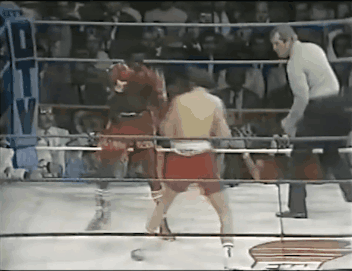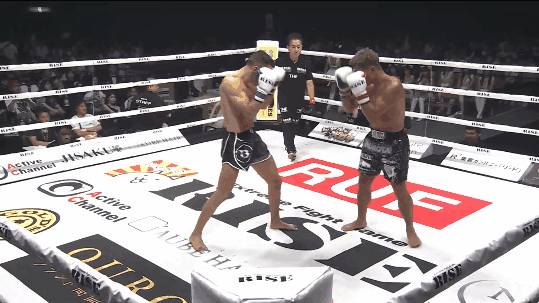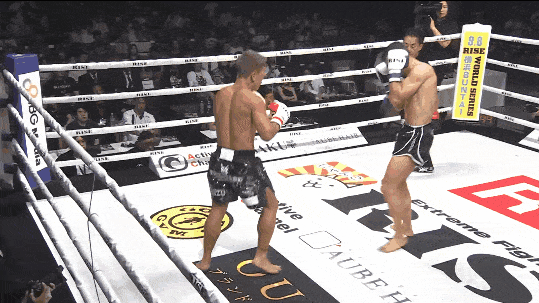3 Fighters You Should
Be Studying – May 2025
Azumah Nelson
Having watched a thousand different fighters over the course of the last thirty years, there are three great pleasures that remain for me in combat sports. The most obvious is a young talent with untold potential. A rarer and even more enjoyable find is a fighter on whom I thought the book had been written, but who suddenly begins to improve late in his career. The third is finding a legend of the fight game whose career somehow fell into one of my blind spots.
Azumah Nelson is probably Africa’s greatest boxer and his prime occurred in the peculiar period of featherweight boxing, after Salvador Sanchez died tragically at 23 years old. Sanchez’s last fight was a gruelling fifteenth round stoppage of a young Nelson to defend his WBC title, and as Nelson claimed that title two years later and defended it for the next five years, the Sanchez “what if” came to loom large over his career.
Nelson was a boxer-puncher in the best sense. He did enough classical boxing to set up good counter punches, and sold out on those in order to score knockdowns or finishes.
Take for instance this beautiful offensive set up against Gabriel Ruelas, where Nelson pumps a double jab, and uses the return of the second jab to perform an inside hand trap, creating a hole through which he can fire his right hand.
Another facet of Nelson’s game that delights me is his use of the left uppercut. This is the trickiest punch in boxing, but devastating when done right. Nelson used his like the awkward Alexis Arguello: when he was in close he could find you with the left uppercut wherever you slipped to. He also used it as a longer, upjab type of punch to set up his thunderous right hand.
When Nelson met Pat Cowdell—who had gone the distance with Sanchez and lost a split just a couple of years earlier, and possessed grit and a solid chin—Nelson was able to time a left uppercut on the inside that knocked Cowdell out for the first time in his career, in just two minutes.
Eleven years later, an aged Nelson leaned on the left uppercut to secure his last professional victory against Jesse James Leija, a fighter whom he had already fought twice and failed to beat. In that third fight, Nelson went Old Foreman mode: adopting the cross guard and marching into Leija’s chest to pound in uppercuts and counter uppercuts on the inside.
A menace on the inside and outside. A powerful hitter and a classy defensive fighter. Azumah Nelson could do it all and there might be no more fitting nickname than “The Professor.”
Taiga Kawabe
When Takeru was storming through the 2014 and 2015 K-1 tournaments, Taiga Kawabe was his unfortunate rival. In 2014 they met in the first round of the -65kg grand prix and Takeru hit Taiga with a backfist that left him stiff, underneath the bottom rope. A year later, the two met in the final of the -55kg grand prix and the relentless Takeru kept Taiga covering up against the ropes until the final bell.
Taiga continued to have decent results in K-1 for a couple of years, and then in 2017 he hit a slump so severe it would make BJ Penn blush. In three years and ten fights, Taiga tasted victory just once. He was stopped four times in this period. It looked as though the young Japanese fighter had burned out in the way that the mad sparring habits of Japanese gyms seem to encourage.
Then, over the next four years, Taiga fought eleven times and lost just once. He carried a five fight winning streak into a RISE title fight against Chanh Hyung Lee, and he cruised to one of the most impressive victories of his career.
That made-for-cinema story is enough to be notable, but the way in which Taiga adjusted his style and the control he took in his later fights demand further attention. I have no proof that Taiga has been studying Giorgio Petrosyan, but he seems to have adopted the essence of The Doctor’s game.
Petrosyan recognized that in the tit-for-tat, three round sprint of kickboxing, the man who can deny his opponent their “turn” with some level of consistency will inevitably win. To break off his opponent’s attack, Petrosyan would either turn them, or smother or shove them.
Here is Taiga firing off a one-two and using the counter right hook to step out the side door just as his opponent begins their “turn.” The two men reset and Taiga attacks again, this time shoving his opponent backwards at the end of the attack to prevent a return. These are small details but crucial, because they kept Taiga on the offensive for the entirety of the clip, in a sport where much of the action takes on the dynamic of “attack, return, attack, return.”
The southpaw right hook and using it to cut the angle into the pivot is a very Petrosyan look, and Taiga can apply it because he is also a southpaw and finds himself in open stance match ups. But the shoving element of Petrosyan’s game is one that anyone, in any stance or stance match up, can steal and apply immediately. Here Taiga shoves his man back back and corners him, allowing Taiga to get off a couple of good combinations, before breaking off line with the pivoting right hook again.
Much of Taiga’s offence is pretty simple southpaw stuff: left straights and hard left round kicks. But he has found good use for a step through spinning backfist, and a great deal of his ire is focused on the opponent’s rear leg. Not only will he chop in powerful left round kicks and front kicks (or “Yoza kicks”) to the opponent’s rear leg, he will use his lead foot to snipe front kicks to the opponent’s rear leg as well.
Here Taiga throws a lead leg front kick at his opponent’s rear leg—a very awkward movement—but uses it to fall into a one-two punching combination on inside foot position.
I recalled Taiga’s title winning effort against Chan Hyung Lee as the most heartwarming fight of last year, but revisiting it today I could not believe how one-sided and convincing Taiga’s performance was. Save this one for later and surprise yourself the next time you are looking for a way to fill a slow half hour in a waiting room.
Sadly, Taiga is part of the great Jkick exodus. Earlier this year Taiga turned up on a Rizin card, in a bizarre MMA match with former Rajadamnern stadium champion, Genji Umeno. Taiga—who had already bested Umeno under kickboxing rules in 2021—lost the fight and now has a record of 0-1 in the sport he vacated his world title to pursue full time.
The only upsides are that he shot some surprisingly nice double legs, and that in spite of thirteen years of professional fighting he is still only twenty-eight years old! So as sad as it is to see Taiga abandon kickboxing at the peak of his powers, there is always the slim, glimmering chance that he becomes a good MMA fighter.
Anantasak
There are three titles to get excited about in Muay Thai. The first two are the Lumpinee and Rajadamnern stadium championships. The third is the Fighter of the Year award. Anantasak never succeeded in capturing a belt at Lumpinee or Rajadamnern—only the less sexy Omnoi Stadium—but he was awarded the Sports Writers Association of Thailand’s Fighter of the Year Award in 1997.
Anantasak is another in the long line of talented Nak Muay who took time off to box and attempted to make the Olympics. Unfortunately, the great (and now disgraced) Somrak was team Thailand’s man at that weight and Anantasak was never able to realize his dream.
If you watch enough Muay Thai you will notice that the sport does not favor combination punching. The clinch, knees, and the high valuation of kicks even landed on the arms all work against extended flurries of two-fisted hitting. Anantasak’s boxing within a Muay Thai context was more about sneaking in a good, hurting southpaw left hand a few times a round.
This is where Anantasak’s teep came in. He used the teep, and particularly the teep to the lead thigh, to get the opponent standing on one leg, and then slid in and thumped them with his left hand in the brief moment he could do it without getting tied up or kneed.
Many of Anantasak’s best left hands also came out of the check. This hammers home the necessity of being able to fight from a short stance—where the check and the teep are readily available—and then momentarily assuming a boxing stance for hitting, if you want to do good work with your hands in Muay Thai.
One of Anantasak’s best shots was his left uppercut. The uppercut occupies a peculiar place in Muay Thai because it works well, but for completely different reasons than it does in boxing. In boxing the uppercut punishes the opponent’s head movement, they are most vulnerable to it when their head sways out away from their hips.
Holy fucking shit dude pic.twitter.com/pRGGuyVTTY
— 🖤Willion Dollar Bill🖤 (@Willbutreal) May 25, 2025
In Muay Thai, the stance is mostly upright and square because of the need to check kicks, but this means that the centreline is more readily available. Where the hands are set to parry straight punches, the uppercut can come in from below them. Against an upright opponent it is often necessary to extend your arm into the uppercut so that the punch goes forwards from underneath, rather than up at the ring lights.








